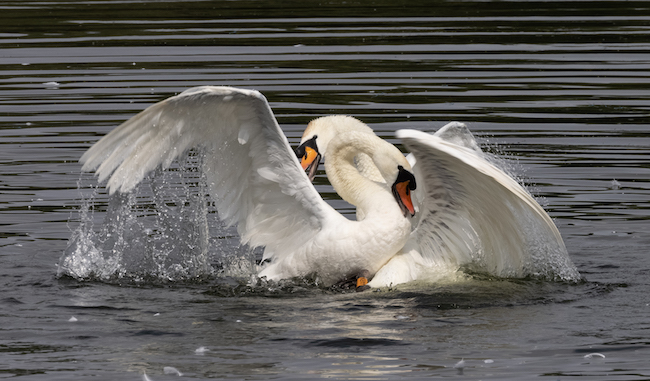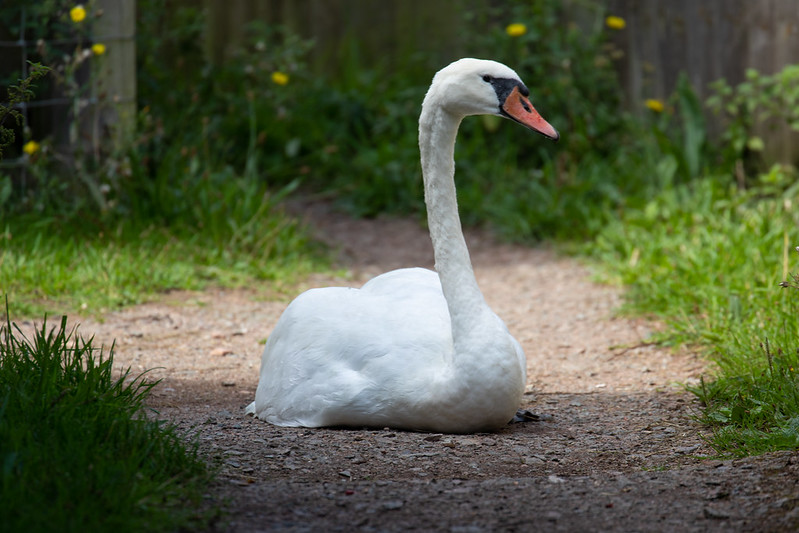- Home
- Identifying birds
- Ducks in the uk
Getting to Know Ducks in the UK
Ducks are often the birds we see without really seeing.
Familiar shapes in parks, flashes of colour on a distant lake.
But the more time you spend near water, the more you notice—their behaviours, their differences, the way they fit into the seasons like moving pieces of the landscape.
You don’t need to be a birdwatcher. You don’t need special gear. Just the willingness to pause and notice them.
This guide is here to help you spot and enjoy some of the wild ducks in the UK—where to find them, what to look for, and a few stories from my own time watching them.
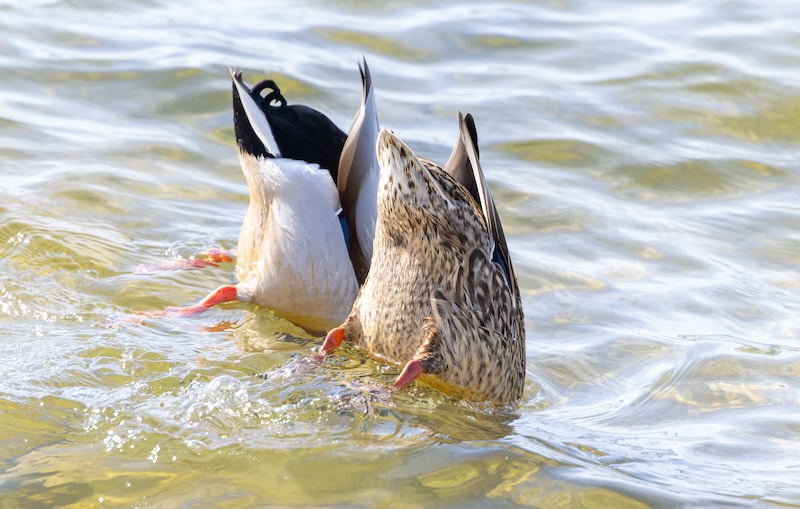 A classic dabble — nothing like a bit of synchronized bottom-up feeding to start your duck-watching journey with a smile.
A classic dabble — nothing like a bit of synchronized bottom-up feeding to start your duck-watching journey with a smile.Where to See Ducks in the UK
Ducks are wonderfully adaptable. Some stay year-round, while others arrive only for the winter or pass through in spring.
You don’t need to go far to find them—just water, and a little patience.
Here are some of the places you might look in the East of England (where I am based):
Parks and Local Ponds
Start close to home.
Urban parks often host Mallards and Tufted Ducks, and you may be surprised by what turns up in the quieter corners.
A little backwater or shaded reedbed can sometimes hold something unexpected.
Wetlands and Nature Reserves
Places like Paxton Pits, Rutland Water, and Summer Leys (if you’re nearby) are ideal for duck-watching.
Look for hides, boardwalks, or quiet viewing spots. Many reserves are accessible, with flat paths and good signage.
Lakes and Reservoirs
Diving ducks often prefer deeper water.
Reservoirs like Grafham Water are excellent places to see Pochard, Goldeneye, and even Smew in winter.
A simple bench or shoreline path can give you a peaceful place to watch.
Coastal Estuaries and Harbours
Sea ducks such as Eider, Scoter, and Long-tailed Duck tend to favour coastal waters.
Harbours, tidal estuaries, and sheltered bays are good places to scan—especially on still days.
Some, like the harbours around Seahouses or the shores of Lindisfarne, (both in Northumberland) offer both birds and breathtaking views.
Unexpected Places
Old watercress beds, canal edges, narrow streams through farmland—ducks can turn up in all sorts of quiet corners.
I once saw a Mandarin with ducklings in an abandoned cress bed near my parents' home, and a single Goosander sunning itself on a quiet riverbank.
These surprises are part of the joy.
Ducks Through the Seasons
Ducks are present all year round—but not always the same ducks, and not always in the same way.
The more often you visit a local patch, the more you start to notice the subtle rhythms of duck life unfolding through the seasons.
❄️ Winter
Many ducks arrive from colder parts of Europe to spend the winter here. T
his is the best time to see sea ducks and rarities like Smew, Goldeneye, and Wigeon.
Look for larger flocks, vibrant plumage, and lively courtship displays starting in the new year.
🌸 Spring
Spring brings a change in mood.
Courtship displays become more frequent and purposeful. Pairs form, and some ducks—like Garganey—may pause briefly during migration.
Listen for softer calls and watch for the first hints of nesting behaviour.
🌤️ Summer
It’s quieter in summer, but not without interest.
Ducklings appear, often in single-file parades or huge creches looked after by an "aunt".
Some males go into eclipse plumage, making them harder to recognise.
Look closely and you’ll still see movement, moulting, and slow family stories playing out on the water.
🍂 Autumn
Autumn brings a feeling of reset.
Migrants begin to return, plumage sharpens, and the waters feel busier again.
Moulting ends, and many ducks shift into their boldest colours.
A good time to get re-acquainted with your regular spots.
Types of Ducks You Might See in the UK
Ducks are more than just mallards on the pond. From quiet river bends to breezy estuaries, a little stillness reveals a surprising variety of species—each with its own rhythms, colors, and surprises.
Dabbling Ducks
Feeding with their tails in the air and heads in the shallows, these are the ducks you’re most likely to see on park lakes, marshes, and rivers.
They don’t dive deep. Instead, they sift the surface—tipping up to reach submerged plants and insects, or grazing along the edges of the water. Their movements are often calm and companionable, and their behaviours easy to watch even from a distance.
Some are bold and familiar, like the Mallard. Others, like the Gadwall or Teal, reward a closer look with surprisingly intricate patterns and colours.
If you're just starting to notice ducks, these are likely to be your first friends.
They don’t need to be rare to be beautiful.
You just need to be still long enough to notice.
Mallard
Familiar, yes. But there’s something comforting in their presence.
The males shimmer with glistening green heads that catch the light like oil on water, and a curled black feather at the tail that always seems a bit cheeky.
Their wing flashes a band of rich blue, bordered by white.
And of course, there’s the quack—the classic duck call that everyone knows, ringing out from reeds and riverbanks like a signature.
Mallards are everywhere, but they’re never just background.
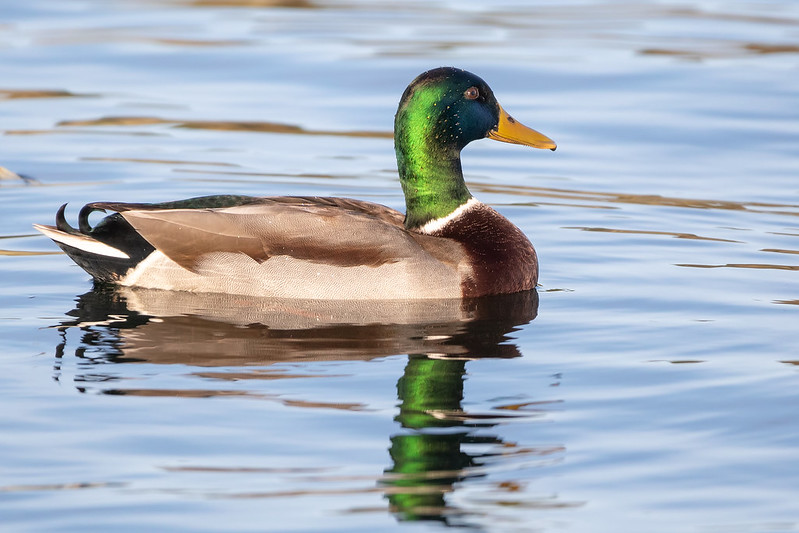 The familiar Mallard, but never just ordinary. That shimmering green head, the curled black tail, and the comfort of something known and still full of detail.
The familiar Mallard, but never just ordinary. That shimmering green head, the curled black tail, and the comfort of something known and still full of detail.Gadwall
Easy to overlook until you really study them.
From a distance, they seem plain—but get close and the detail is astonishing. T
he males wear a delicate weave of tiny black and white patterns, like a fine etching.
They don’t shout for attention. They reward it.
If you listen closely, you might hear the male’s odd little call—a soft, burping sound that feels more comical than elegant, but somehow suits them.
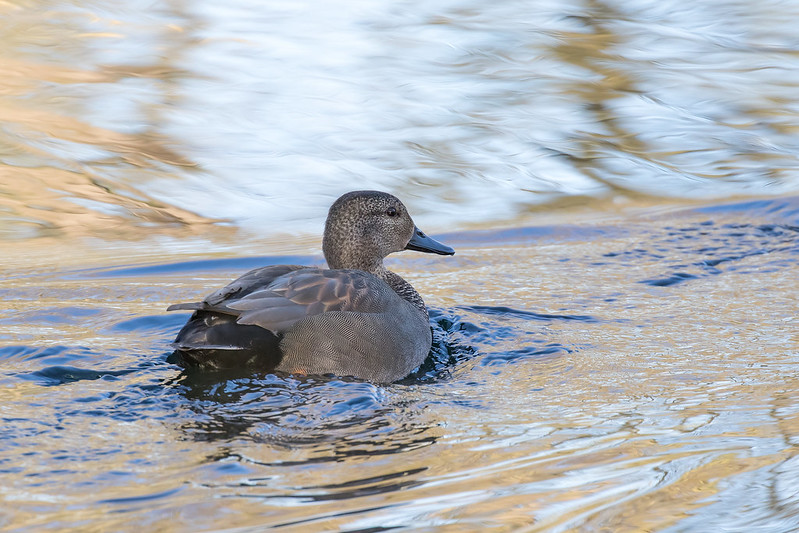 A quietly handsome Gadwall drake drifts by. Understated at first glance, but full of intricate detail if you take a moment to really look.
A quietly handsome Gadwall drake drifts by. Understated at first glance, but full of intricate detail if you take a moment to really look.Teal
They’re the smallest duck you’re likely to see in the UK—and sometimes the fastest.
Males are unmistakable once you know them: rich chestnut heads with a bold green stripe sweeping from eye to neck, like war paint.
When they’re feeding, they bob busily in shallow water, heads down, tails flicking. Look closely and you’ll spot a little cream patch just in front of the tail, like a tiny sail catching the breeze.
In flight, they move like a murmuration—tight flocks twisting and flashing over the reeds.
Their call is high and whistling, like a distant dog toy. You might hear them before you see them.
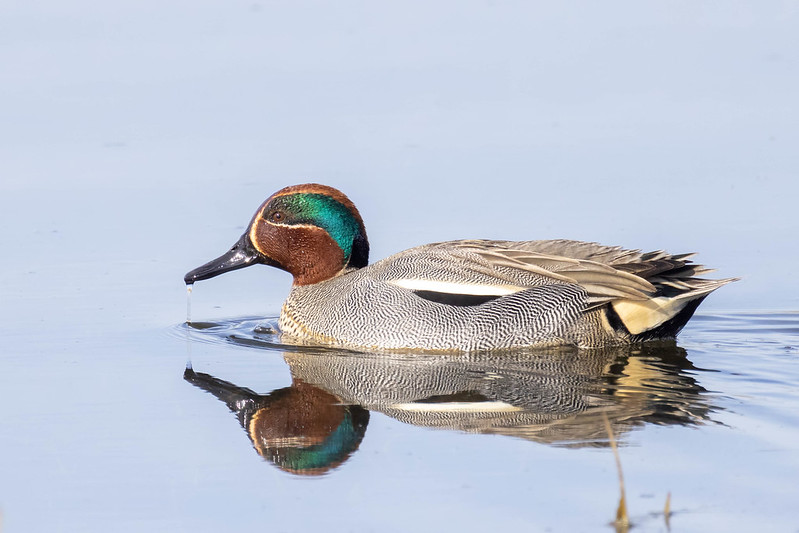 A beautifully marked Teal drake, caught in still water. That bold green stripe and the soft cream patch near his tail are easy to miss—until they catch the light just right.
A beautifully marked Teal drake, caught in still water. That bold green stripe and the soft cream patch near his tail are easy to miss—until they catch the light just right.Wigeon
There’s something dapper about a male Wigeon. With his cinnamon head and pale cream crown—like a perfectly placed parting—he always looks a little dressed up.
You might find them not only on lakes and lagoons, but out in damp meadows, quietly grazing in loose flocks. Heads down, tails flicking, they look contentedly at home in the grass.
Their call is a gentle, rising whistle—soft and clear, like a tune carried on the wind. Not loud, but memorable.
They seem to glow in winter light, their warm colours a kind of quiet brightness on grey days.
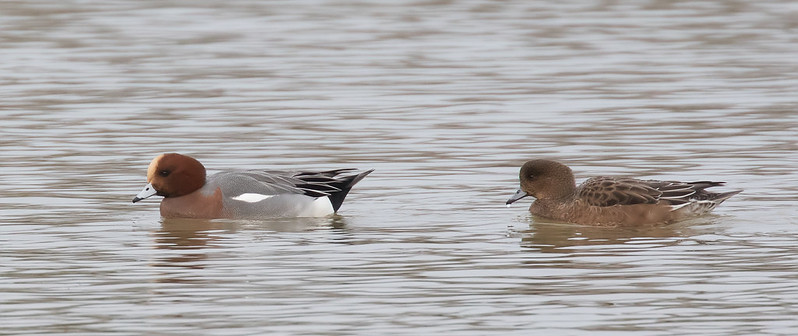 A well-dressed pair: the male Wigeon with his creamy crown and warm tones, his partner more reserved but every bit as elegant in her own way.
A well-dressed pair: the male Wigeon with his creamy crown and warm tones, his partner more reserved but every bit as elegant in her own way.Shoveler
You’ll spot them by the bill first—long, broad, and flat like a spoon.
Males are boldly patterned, with deep green heads, white chests, and rich chestnut flanks.
But it’s how they feed that really makes them stand out.
They spin in slow, deliberate circles—often in pairs or small groups—heads low, bills skimming just beneath the surface. They’re filtering tiny food from the water, like aquatic sieves at work.
I watched a pair doing just this at Summer Leys, circling together in perfect rhythm, round and round, as if they’d choreographed the whole thing. It was oddly calming—and a little hypnotic.
Diving Ducks
Not all ducks dabble. Some dive.
These birds favour deeper lakes and reservoirs, where they vanish beneath the surface for long seconds at a time—chasing food that floats out of reach for their dabbling cousins.
They resurface without fuss, often in a new spot entirely, as if reappearing by magic.
You’ll see them in small groups, sometimes mixed with grebes or Coots.
Watching them is a slower rhythm—less noise, more stillness. But always worth the time spent.
You never know where they’ll surface. That’s part of the magic.
Tufted Duck
One of the most common diving ducks in the UK, but still full of personality.
Males are striking in sharp black and white, with a little drooping crest and those vivid yellow eyes that seem to glow in certain light. One moment you see them and the next they diving popping back up like floating corks.
Females are softer in tone—rich brown with a neater head shape—but equally busy below the surface.
Tufties have a certain confidence to them. They don’t pose or parade. They just get on with things, quietly brilliant and a little bit punk.
I often see them at Grafham Water, where they mingle with Great Crested Grebes and Pochard. A perfect place to watch diving ducks in action.
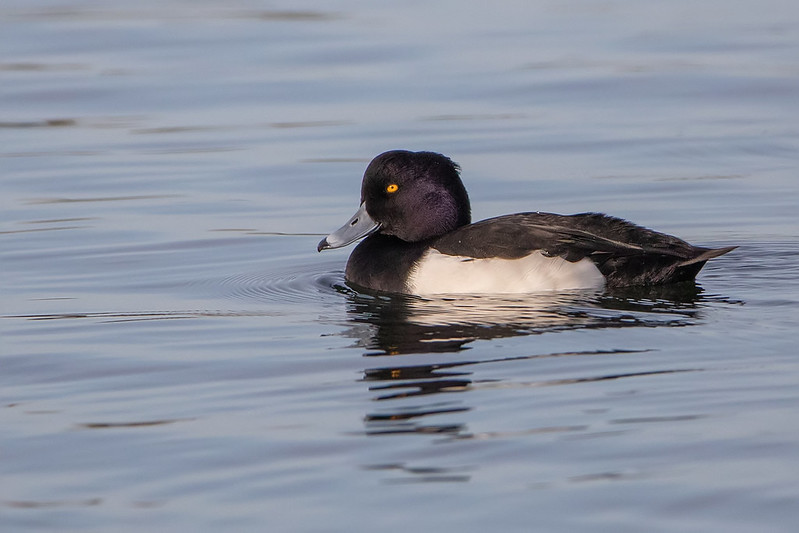 A Tufted Duck in calm light—crisp black and white, bold yellow eye, and that little swept-back crest that gives him a bit of attitude
A Tufted Duck in calm light—crisp black and white, bold yellow eye, and that little swept-back crest that gives him a bit of attitudeRed Crested Pochard
You often see them before you realise what they are.
I saw this pair gliding together on still water.
When the male’s bright orange head caught the light I did a double take! Coupled with a vivid red bill and smart black chest he was a handsome bird.
His mate followed, softer in colour but equally beautiful. Her pale cheeks and gentle colours differed from the nondescript plumage of many female ducks.
They’re not always easy to find, and not as widespread as some species, but they’re quietly turning up more often across the UK.
A surprising splash of brightness on a quiet lake.
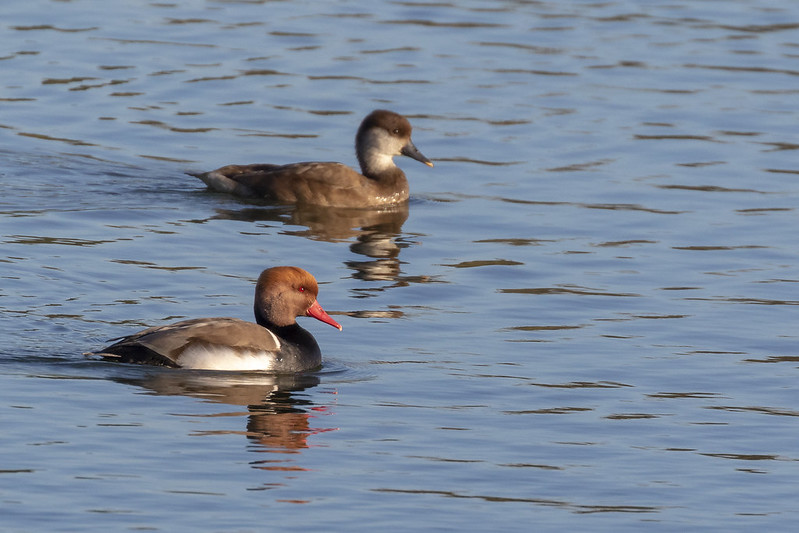 A Red-crested Pochard pair, moving quietly through the morning light. He draws the eye with that brilliant head and bill—but she has her own kind of softness.
A Red-crested Pochard pair, moving quietly through the morning light. He draws the eye with that brilliant head and bill—but she has her own kind of softness.Goldeneye
Small and sharp-looking, with bold black-and-white plumage and a round white cheek patch that seems painted on. But it’s their eye—a pale, clear gold—that gives them their name and their presence.
They’re winter visitors on deeper lakes and slow rivers, often keeping to themselves or diving with quiet precision.
But if you’re lucky, you might witness their courtship display: the male throws his head back so far it touches his back, kicking up a splash with his feet in one smooth, theatrical gesture.
I’ve watched this at Grafham Water, while sitting quietly in one of the hides. One minute they were swimming along, and the next they performed their dramatic head throw and surprised me.
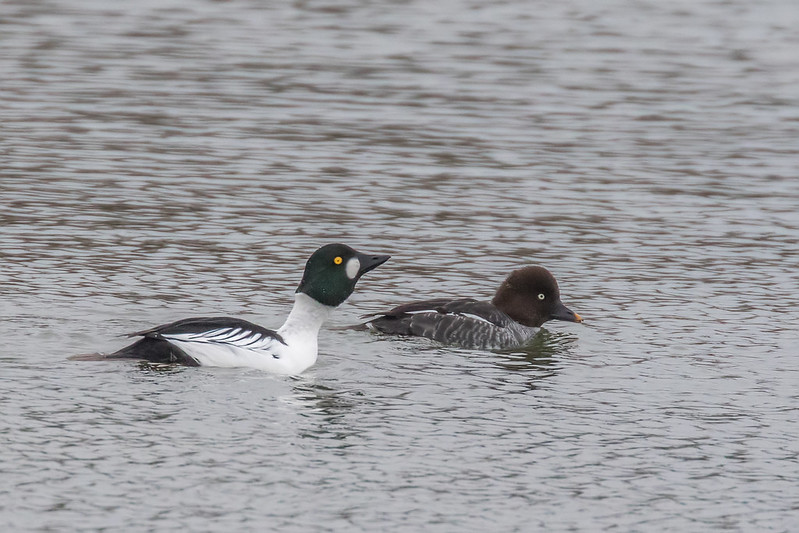 A pair of Goldeneye, quietly moving across the lake. That crisp cheek patch and piercing yellow eye give the male his name—but it’s their sudden, theatrical courtship that really takes you by surprise.
A pair of Goldeneye, quietly moving across the lake. That crisp cheek patch and piercing yellow eye give the male his name—but it’s their sudden, theatrical courtship that really takes you by surprise.Low light. Cold air. Ducks you’ve never seen before,
suddenly there as if they’d always belonged.
Garganey
A rare and beautiful spring visitor, often here for just a short time as they pass through on migration.
Males wear an unmistakable white crescent over the eye, curved like a brushstroke against deep chestnut and soft grey.
I saw them just once, at Summer Leys—a little group of two males and a female, moving quietly up a narrow channel beside the scrape.
(A scrape is a shallow, manmade wetland designed to attract waders and waterfowl—easy to overlook, but often full of life.)
The birds slipped through the water with quiet purpose, never hurried but never still. Then, without fuss, the female lifted into the air, and both males followed close behind.
It felt like I’d glimpsed something brief but meaningful.
Sea Ducks
Some ducks are shaped by the sea.
These are hardy winter visitors—birds that ride the wind and waves with ease, diving deep in salty water and vanishing beneath the surface for longer than you’d expect.
You’ll mostly find them offshore or in broad estuaries, often distant and quiet, drifting in loose groups or flying low over the surf.
They aren’t always easy to spot. But when the light catches them—or when you hear the soft echo of their calls across the tide—they feel like part of something much older than the shore.
Eider
Britain’s heaviest duck, and perhaps its most soothing.
Males wear bold black and white plumage with a soft green nape, their profile sloping and smooth like sea-polished stone.
The female Eider is beautifully patterned in warm browns, perfectly suited to her nesting grounds. I’ve shared a closer look at her plumage over on my bird feather patterns page if you’d like to see the detail.
I saw them on a trip to Seahouses in Northumberland, floating calmly in the harbour as the boats set out toward the Farne Islands—full of people hoping to spot puffins or seals.
The Eiders, unbothered by the bustle, drifted between the moorings as if they owned the place.
Their call—a soft, crooning ah-ooo—was like nothing I’d ever heard before. Gentle and almost comforting, as if the sea itself had a voice.
They belong to the coast—part of the rhythm of salt air, tide, and distant wings.
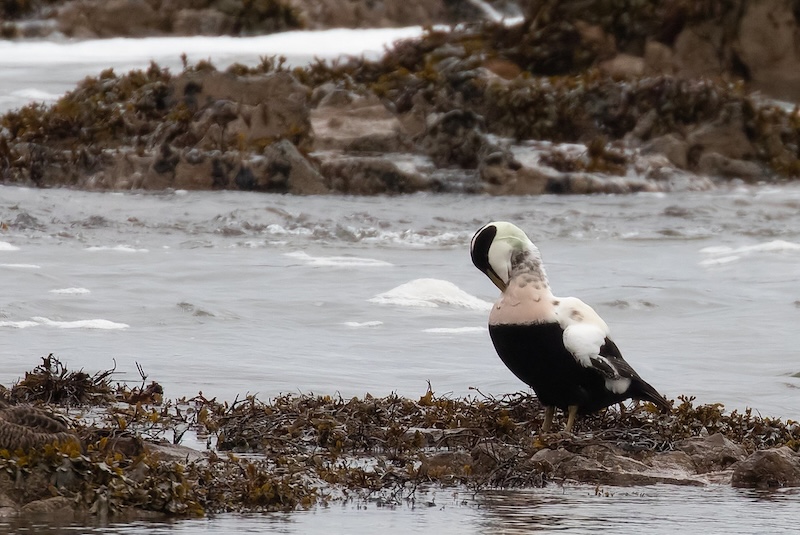 A male Eider on the Northumberland coast, pausing mid-preen among the seaweed and stones. Built for the sea, but never in a rush.
A male Eider on the Northumberland coast, pausing mid-preen among the seaweed and stones. Built for the sea, but never in a rush.The sea was still, the boats were quiet,
and the Eiders drifted like thoughts too calm to name.
Common Scoter
You don’t always get a close look.
I saw a small flock once, far out on the sailing lake near Titchmarsh—just dark silhouettes bobbing in the ripple.
I wouldn’t have noticed them on my own, but someone nearby pointed them out, and through the binoculars, I caught the shape and movement. They were low in the water, sleek and steady, heading into the wind.
No photo, no perfect moment—but still a memory.
Common Scoters are sea ducks through and through—glossy black and fast-flying. They often travel in tight groups, calling with a soft, musical whistle.
Most sightings are distant, but that doesn't make them any less real.
Velvet Scoter
These are the ones you almost don’t see.
Heavy-bodied sea ducks, usually distant—black shapes rocking gently in the glitter of far-off waves.
But if you catch them in the right light, you might notice a gleam of white in the wing or a flash of pale face marking.
Velvet Scoters spend most of their time well offshore, diving deep and travelling in low, fast lines.
They're winter visitors here, and most sightings feel like glimpses through a veil—something present, but just out of reach. Not every bird needs to be close to leave an impression.
Long-tailed Duck
A bird of cold seas and deep water, the Long-tailed Duck is one of winter’s rarest and most beautiful visitors.
Males wear bold white and chocolate plumage with slender tail streamers trailing like ribbon.
Their calls—liquid and bell-like—are almost too lovely for such stark environments.
I haven’t seen one in person yet, but they stay on my list—not just for the chance of a photograph, but for the moment itself. Some ducks feel like treasures. This is one of them.
Sawbills ((Fish specialists with serrated bills)
Built for speed, and built for fish.
Sawbills are long, narrow ducks with sharp, serrated bills—perfect for catching slippery prey beneath the surface.
They’re strong swimmers and quick divers, often found in cold rivers or coastal inlets, gliding low in the water like purposeful little torpedoes.
They feel a little wilder than some of the other ducks—more focused, more alert.
When you see one, it’s usually on the move. But now and then, they rest. And when they do, their elegance is just as striking.
Goosander
Long-bodied and low in the water, Goosanders are sharp and graceful.
Males wear crisp white and black with a gentle green gloss to the head.
Females are softer—grey-bodied with a chestnut crest that lifts in the breeze.
At Paxton Pits, I watched a lively pair darting and diving together on the Heronry Lake—synchronised, alert, and full of energy.
At Thrapston Lakes, by contrast, I once found a lone male just shuffling quietly along the riverbank, content to loaf and preen in the cold light.
There’s a steadiness to them—whether active or at rest, they always seem to carry themselves with quiet purpose.
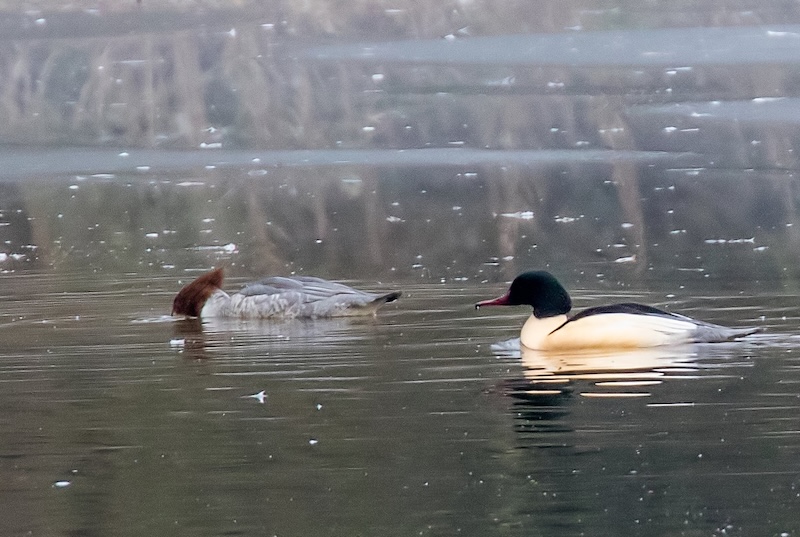 A pair of Goosanders on the move—he cruising calmly, she already slipping beneath the surface. Purposeful, elegant, and quietly in sync
A pair of Goosanders on the move—he cruising calmly, she already slipping beneath the surface. Purposeful, elegant, and quietly in syncRed-breasted Merganser
Slimmer and scruffier than the Goosander, with a wild punk crest and bright red eye.
They’re often coastal, more salt than freshwater, and they move with speed and energy—always diving, always active.
I saw one while visiting Lindisfarne, close to the rocks, its head just breaking the water as it hunted along the shore.
I didn’t get a photo—but I remember the shape, the flash of movement, the salt wind at my back.
Some sightings stay with you precisely because they don’t stay still.
Smew
A true winter gem.
The male Smew looks like fine porcelain cracked with ink—white feathers etched with sharp, black lines. He’s small but striking, like a minimalist artwork afloat.
His partner, often close by, is subtler: dusky grey with a warm russet cap, alert but reserved.
I saw them at Rutland Water, drifting between the reeds with the light catching on the male’s brilliant contrast. Even from a distance, they seemed like something rare and carefully drawn.
He may not call out or chase, but his presence is undeniably bold—elegant and impossible to miss.
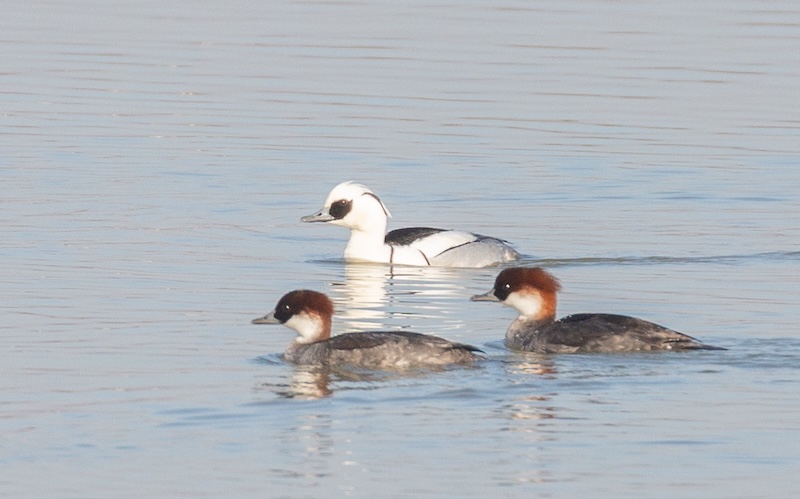 Three Smew on a winter lake—the bold male like cracked porcelain, the redhead females softer but full of poise. A fleeting moment, and one to remember.
Three Smew on a winter lake—the bold male like cracked porcelain, the redhead females softer but full of poise. A fleeting moment, and one to remember.Mandarin Ducks
Some ducks don’t look real.
The Mandarin is one of those birds you almost doubt, even as you watch it walk past.
The male’s plumage is a riot of colour and shape—burnt orange sails, crisp black-and-white markings, deep blues and purples that shimmer in the right light.
The female, though quieter, is every bit as beautiful in her own way—subtle spotting, soft tones, and a calm, alert gaze.
They aren’t native to the UK, but they’ve found a place here in wooded parks, shaded streams, and quiet rivers. You might spot them perching in trees or slipping silently through reflections.
They arrive like a final surprise. And they linger.
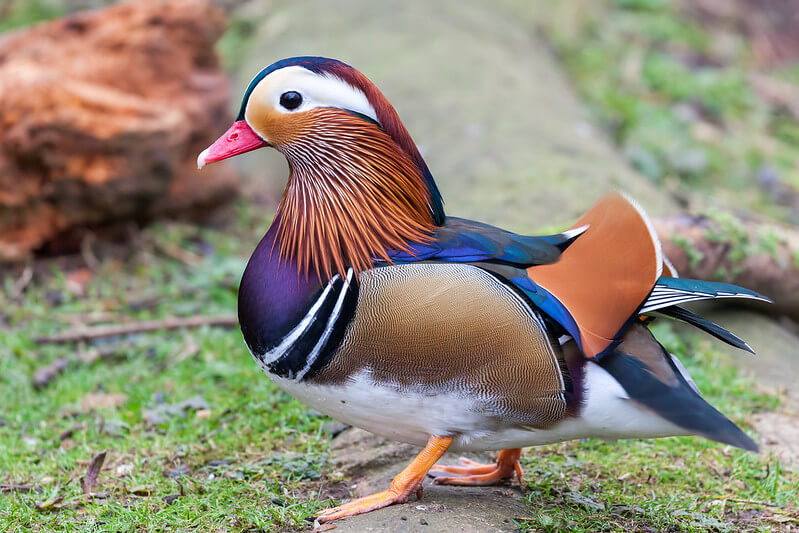 A male Mandarin in full colour—part bird, part brushstroke. One of the most extraordinary ducks you’re ever likely to meet on a quiet woodland walk in the uk.
A male Mandarin in full colour—part bird, part brushstroke. One of the most extraordinary ducks you’re ever likely to meet on a quiet woodland walk in the uk.Mandarin ducklings are raised in tree holes. When it’s time to leave the nest, they leap to the ground—sometimes from several metres high—guided only by the sound of their mother’s call.
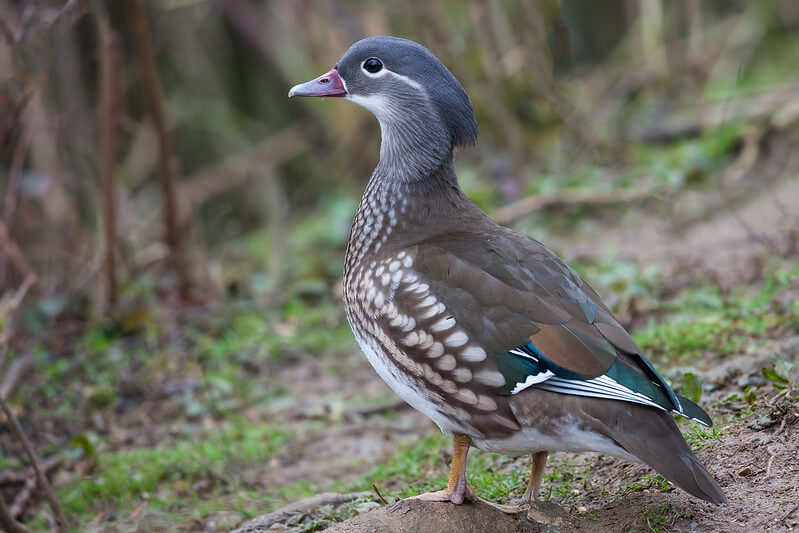 The female Mandarin may not wear the same colours, but she’s full of quiet charm—watchful, elegant, and every bit as wild.
The female Mandarin may not wear the same colours, but she’s full of quiet charm—watchful, elegant, and every bit as wild.Closing Reflection
Ducks are often the first birds we notice near water.
Familiar, yes—but once you start really seeing them, the variety, beauty, and quiet drama unfolding on ponds, rivers, and coastlines becomes something quite special.
Whether it’s a Mallard at your local park or a glimpse of a winter Smew far from home, each sighting holds a story of its own.
If you’d like to keep exploring, I’m working on a few resources that might help:
Both will be available as PDFs—easy to save or print. (I’ll add the download links here when ready.)
So if you can, take a quiet moment this week. A short walk near water. A pause on a bench. You might spot something you’ve never noticed before.
Not every duck needs colour to stand out.
Some are beautiful because they belong exactly where they are.
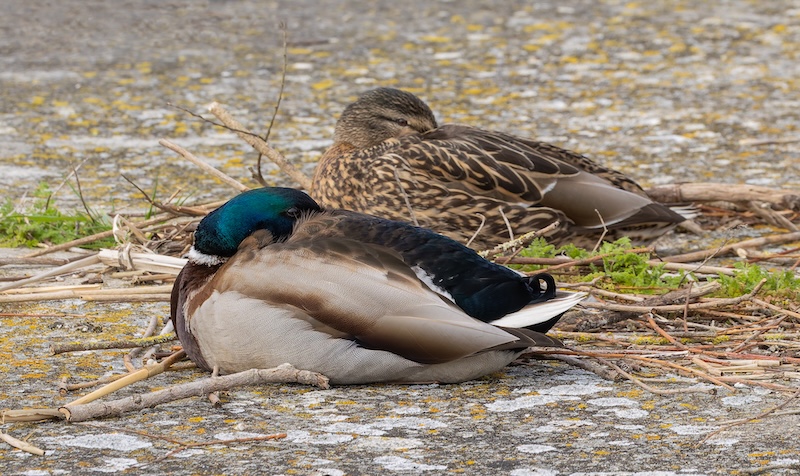 After all the paddling, a pause. Ducks remind us that rest is part of the rhythm, too
After all the paddling, a pause. Ducks remind us that rest is part of the rhythm, too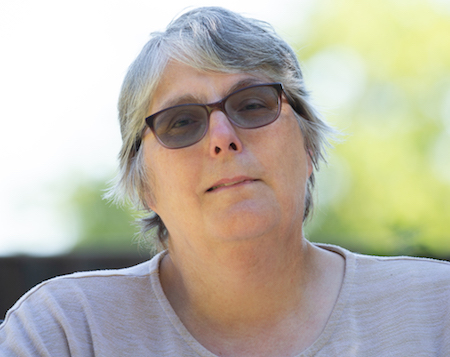
About the Author
Carol is a UK-based wildlife photographer and nature writer with a passion for peaceful walks, patient observation, and capturing life’s quiet wonders.
Through her lens and words, she shares the stories of the natural world — from bluebells and butterflies to birds like the great crested grebe.
Get closer to UK nature
Subscribe to Wild Lens!
Want to discover more hidden walks and wildlife moments?
I’d love to share my latest nature finds, photo tips, and peaceful walk recommendations with you.
💌 Join my newsletter Wild Lens—it’s free, occasional, and always rooted in a love of the natural world.
Subscribe below and come exploring with me.



